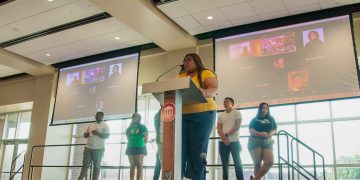As humans, we like to pride ourselves in the fact that we’re the only animal species able to use language to communicate meaning – however, recent research shows that may not be exactly true.
Thursday night at Brevard Hall, Angela Dassow, assistant professor of biology at Carthage College, used research to argue that white-handed gibbons are capable of expressing specific meanings through vocalizations. Gibbons are a type of ape.
Ultimately, if we program a keyboard to play gibbon calls, Dassow said, we could potentially be able to communicate with them.
“I haven’t tested it yet. I want to learn a little more gibbon and get better at playing a keyboard before I test whether or not these gibbons will communicate with me,” Dassow said. “But it’s a future goal.”
During her doctoral research, Dassow observed wild gibbons in Thailand and captive gibbons at various zoos around the country in order to understand the potential effects captivity has on their vocalizations.
In both groups of gibbons, Dassow recorded calls under natural conditions and also introduced context-appropriate stimuli, such as models of predators for those in the wild and a veterinarian for those in captivity.
Dassow then spent 10 months looking for distinctions between vocalizations and possible sources of variability.
“One of the challenging aspects of any kind of acoustic research is determining what these boundaries are going to be,” Dassow said. “It’s somewhat subjective in terms of who is coding, which is where computational analysis comes in.”
Dassow used technology to make sure her observations were accurate and ultimately determined there are 27 categories of sound in gibbon communication.
The greater question, however, is whether or not these acoustic units actually signify meaning, which is what Dassow investigated next.
“We want to look at what those patterns are – how they’re combined and whether or not they’re used in any sort of predictable way,” Dassow said. “If I can find a repeated sequence that’s always associated with predators, can I expect to go to another gibbon group and see that repeated with their communication as well?”
Through analysis, Dassow eventually isolated two concise subsequences of gibbon vocalizations, one which is a generic predator warning and one which specifically warns of a snake.
“This first subsequence is a motivational sequence made up of just two different sounds meaning that the organism is alert but not necessarily referring to anything specific,” Dassow said. “Whereas the second subsequence is a referential type of vocalization – there is an associated meaning with that.”
Predator warning calls appear to be more complex than previously thought, Dassow said. More research, however, still needs to be done to understand the extent of gibbon communication and their ability to learn.
Unanswered questions include whether or not animal vocabularies evolve over time and whether or not animal communication has context-dependent words, such as the English word “suck.”
Dassow, however, found that vocalizations differ greatly between captive and wild gibbons, which indicates that limited vocal learning may be occurring.
“Gibbons are innate in their vocal production. In other words, it doesn’t matter if you move them – they’ll still have the same acoustic units,” Dassow said. “But they do appear to learn how to use those acoustic units.”
“I haven’t actually tried to teach a gibbon any sequences yet,” Dassow continued. “But what might be possible is that they’re learning from each other.”
These findings can be applied to studies on the evolution of vocal communication and contribute to conservation efforts.
Dassow said gibbon vocalization research can inform captive-release programs which gibbons are ready to be released. If a gibbon is able to effectively communicate about territorial boundaries and understand when another gibbon group is warning of a predator, its chances of surviving in the wild are much higher.
Freshman mechanical engineering major Sudesh Pathak, who is currently taking Anthropology 101, said he really appreciates Dassow’s research because not only is it interesting, but it also seems extremely challenging.
“How do they do that?” he said. “Those sounds are so similar – I can’t even distinguish the voices of some of my friends.”
























